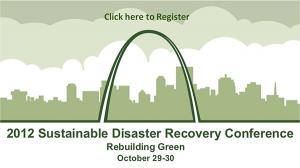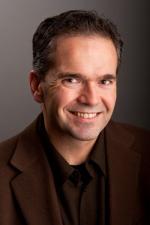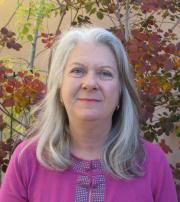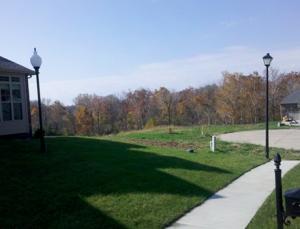- A Look Back at the Sustainable Disaster Recovery Conference
- Green Builder® Coalition Now Accepting Donations
- Impact Series
- As I Am… Margaret Griffes
- Job Opportunities
- Train of Thought
Appearances
A Look Back at the Sustainable Disaster Recovery Conference

The Sustainable Disaster Recovery Conference, presented by The Saint Louis University (SLU) Center for Sustainability, Greensburg GreenTown, and GreenTown Joplin, was held on the St. Louis University campus October 29-30. Its purpose was to help cities stricken by natural disasters rebuild strong, livable communities by identifying ways to efficiently and effectively weave elements of sustainability into the disaster recovery process, while increasing collaboration among all parties working toward this goal. Approximately 200 people, ranging from students to government officials to industry professionals, attended the myriad of educational sessions.
Here is a recap of a few of the presentations we were able to attend:
Monday: Breakfast Plenary
The conference started off strong. This panel consisted of:
Steve Hewitt, former City Administrator of Greensburg, KS
Jonathan Raiche, Planning/Community Development Specialist for Joplin, MO
Dennis Knobloch, former Mayor and current Village Administrator of Valmeyer, IL
All three of these gentlemen have been in positions of authority for towns that have been decimated by natural disasters. Yet all of their messages were upbeat and constructive.
Hewitt spoke about the need for common sense post-disaster. He stated that community leaders need to have a message and stick with it, even if that means taking on criticism in the short-term (an area in which he can speak from experience). He feels public servants need to do what’s best for their community: serve! “Sometimes, that gets forgotten,” Hewitt said. Finally, he advised that is essential to get everyone on board, including the local businesses. “If you don’t have businesses, you don’t have a community,” Hewitt advocated.
Raiche spoke about the need for local involvement during all phases of recovery. He wisely stated, “We had to define our recovery. Our residents had to define it.” They held community meetings in Joplin, and gave residents Post-it notes. There were poster boards at those meeting, conveying design ideas. The residents used the notes to share their thoughts on the various concepts. All feedback was gathered, and a 50-page document was produced and distributed throughout the community. A design charrette was held, with the American Institute of Architect (AIA) lending management assistance.
Knobloch had just entered his 2nd term as Mayor when the Flood of ’93 destroyed 96% of the structures in Valmeyer. The floodwaters topped a substantial flood wall that had been constructed by the Army Corps of Engineers. (Side note: The ACE was able to predict, to the exact spot, where the floodwaters would reach, if the wall was ever breached.) Parts of the town were underwater for over 2 months. They decided to move their town on top of the nearby bluff, so it is now 400 feet higher than the original location. To paraphrase Knobloch’s advice, he said it’s important to have local involvement in the recovery process, because when outsiders come in and tell you what you need to do, locals can add an element of reality to the discussion.
In Their Own Words: The Decision to Rebuild Green
This session was not strongly attended, but the message couldn’t have been more heartfelt. There were two couples, one from Greensburg, KS and one from Joplin, MO. They were joined by a builder from Joplin, MO.
Each couple had different reasons for rebuilding green. Ramona Shields of Joplin, MO said, “We wanted to rebuild green for our family.” They have since been using their home for educational opportunities. Jill Eller of Greensburg, KS shared, “Being green has been a healing experience for us.” A picture of Eller, taken outside of her new home, was published in National Geographic.
Will Perkins, a builder from Joplin, MO, wanted the audience to always consider 4 things: Size, solar orientation, insulation and thermal mass.
Lunch Plenary
Three people, one each from the National Renewable Energy Lab (NREL), FEMA and Department of Defense (DoD), shared the scope and responsibilities of their respective employers as it pertains to sustainable disaster recovery. We felt the big takeaways from this session were the mention of the National Disaster Recovery Framework from FEMA, and the following 2 websites: www.openei.org and www.star-tides.net.
The Science Behind Natural Disasters: What Does the Future Hold?
People love to hear about the future, and that was certainly true as 50-60 people attended this session. Hosted by 3 Earth and Atmospheric Sciences professors from SLU, they discussed temperature, CO2, Arctic sea ice and tornado trends. Some of the data wasn’t a surprise to anyone who’s well read on the subject of global warming. For instance, they demonstrated how temperatures and CO2 levels are rising. Arctic sea ice has significantly decreased over the last 40 years.
Of most interest to us is that the annual number of tornadoes is relatively unchanged. While the number of tornadoes has gone up slightly, they don’t feel it has anything to do with climate change. Rather, they feel the advent of the Nexrad and Doppler radars, along with increased vigilance from storm chasers and other private citizens, is the cause of the slight increase. The experts also shared that it is very hard to predict the total number of tornadoes based on previous years’ totals, or even the 1st half of a current year.
Keynote
This all-attendee session was delivered by Mike Smith of AccuWeather. He took out a proverbial sledgehammer and bashed the National Weather Service in Jasper County, MO (which is where Joplin is located). He also spoke on the need to survive, revive and prosper post-disaster. To expound a bit further, Smith made the following statements:
Survive – “The (climate) science is good, but the local emergency management operating policy is outdated.”
Revive – “Communities that move quickly recover more fully than those that wait.” (We have some issues with that, but don’t have the space here to go into it.)
Prosper – Smith also suggested towns and cities ask themselves this question: “What could my community be if we could start over?” By answering it before a disaster, it should help assist in the event of a catastrophe.
Tuesday: Strategies for Residential Building after Disaster
Joined by Daniel Wallach of Greensburg GreenTown™, the Green Builder® Coalition was invited to present strategies for residential building after disasters. The importance of sustainable construction was stressed, as was the flexibility of both product offerings and techniques. The informative (and occasionally humorous) presentation was well-received by the audience, who engaged in discussion with us long after the session concluded.
Community Rebuilding Workshop
We served as one of the facilitators for the end-of-conference workshop. This informal opportunity allowed conference attendees to ask questions or discuss topics with some of the speakers. It was recorded by a film crew from Greensburg, KS, but it may be some time before it is available for viewing online.
To read a summary of all presentations, as well as bios of the presenters, you can visit the official conference site here: http://www.slu.edu/sustainability/sustainable-disaster-recovery-conference
Activities
Green Builder® Coalition Now Accepting Donations
When the Green Builder® Coalition was founded, the first decision ever made was to restrict membership to individuals only. To allow corporations to join would be recreating the wheel, for they already had industry associations to further their interests. We wanted to represent the small business owner/sole proprietor, as well as other passionate individuals, who did not have an influential voice within the larger, more established organizations.
This decision was not made casually. We knew this would limit our revenue opportunities, as we would not avail ourselves to corporate funding. However, we were resolute in our quest to provide a home for those individuals whose personal values might differ from those of their employer, or organizations of which they may or may not be members.
As time has gone on, we also recognize there may be individuals who feel it too risky to take a public stance against those entities described above, or are simply uncomfortable doing so. By creating a donation form, we are able to provide an avenue for people to support our efforts while shielding those actions from professional ramification.
If you, or someone you know, would like to financially support our efforts, please click here to contribute. We thank you for your generosity.
Impact Series
 On October 24th, Bart Houlahan spoke with Ron Jones, President of Green Builder® Media and Co-Founder of the Green Builder® Coalition, on the topic of For-Benefit Corporations. It was another installment of the Impact Series.
On October 24th, Bart Houlahan spoke with Ron Jones, President of Green Builder® Media and Co-Founder of the Green Builder® Coalition, on the topic of For-Benefit Corporations. It was another installment of the Impact Series.
Houlahan, Co-Founder of B Labs, explored “For-Benefit” corporations: a new, rapidly growing class of organizations that have redefined fiduciary responsibility, governance, ownership, and stakeholder relationships so that they simultaneously and equally value social, environmental, and financial considerations. He also discussed how B Corps utilize innovative legal and accounting practices to achieve a triple-bottom line in a way that makes them not just viable, but increasingly competitive, in today’s economy.
In case you missed this free webinar, you can view it at your convenience. To do so, please visit the Impact Series archive, found here.
As I Am…
 Margaret Griffes
Margaret Griffes
Each issue, we’ll sit down with a green building professional to gain a personal insight into their motivations, inspirations and experiences. This issue, we feature Margaret Griffes, Mega-Volunteer from Colorado.
The Torch: What motivated you to enter the sustainability industry?
Margaret Griffes: After a career in medical microbiology across the US and overseas, we moved to England from Cairo and I bought a home in the mid-1990’s. I decided to remodel it and had my first introduction to building. The UK has many sustainable practices which I enjoyed learning about. It was a successful project so when we moved to Denver I continued remodeling. But it was only in 2007 that I discovered the certificate programs through the Colorado State University extension and took the first one to prepare for, and pass, the LEED accreditation exam. I never thought I’d be riveted listening to a mechanical engineer talk about HVAC systems! I was fascinated about the topics and loved meeting the people. I then took their first Green Building for Homes, followed by a 6 month construction management certificate. Learning about performance, health, SROI, etc., inspired me to learn about and increasingly incorporate sustainable practices
The ongoing projects and people I learn about keep me motivated and excited.
TT: Describe your first green project. Did you encounter any hurdles on that first project? (If yes, how did you overcome them?)
MG: I am involved in my first greening project, an ongoing remodel of an existing 25 year old passive solar home. Great, interesting ideas, but challenging to figure out best outcomes and whom to work with. Deciding how to weigh choices to get the best outcome is the most challenging. Hunting for expertise, lots of research, asking questions, with an involved collaborative team have been the keys to solving each hurdle.
I am currently replacing windows and doors, due to lack of waterproofing, inadequate insulation, water damage, settling from expansive soils, etc.! So far, it’s looking good!
Then, I hope to do the HVAC in 2013, which will be complex in this 25 year old passive solar home.
I am also working on a 9.5 acre residential neighborhood project including our home. We are on hold until we get the right developer/builder and the residential market is ready. My vision is for a neighborhood where the HOA includes sustainability as a foundation, incorporating the best building science currently available. We also are working with a company that started a small organic farm on part of our property 3 summers ago and being a part of the changing land use for sub/urban agriculture is exciting and delicious!!
TT: What building product or technique do you think will be the next “game changer”?
MG: I would love to see residential concentrated solar power (recycling the old satellite dishes?) with greatly improved efficiency. I have also been working on getting the Green MLS as the standard in the residential market. This will have a big influence on the economics to incorporate green features in both new and retrofit homes.
TT: Who inspires you the most?
MG: The people I have met and those I look forward to meeting next! Innovators who bring ideas and products to a point where early adopters are convinced to use them.
I started volunteering with USGBC Colorado almost 5 years ago and am still on both the Education and Advocacy Committees. I started luncheon “Green & Grubs” to make networking and continuing education more accessible in the Denver Tech Center area. My focus is on the talented people doing projects locally and around the world in any aspect of green building. I especially like emerging technologies. The combination of education and advocacy fit me perfectly.
TT: If you had it to do over again, what profession would you choose?
MG: Building science – with an emphasis on planning and execution. I love charrettes, research and site management – problem solving and teamwork. Right and left brain!
TT: What do you enjoy the most when you’re not at work?
MG: Traveling (I speak 6 languages!), skiing, rowing, biking, reading, exploring, talking about and eating local and organic foods at great restaurants, etc.!
TT: What’s the most important piece of advice you’d like to pass along to others?
MG: Network and explore. Reclaim the best of the past, but insist on the best for the future.
Job Opportunities
Below you will find job postings for green collar jobs around the country.
If you have a job opening you’d like to list here, please contact the Green Builder® Coalition at info@greenbuildercoalition.org.
CLEAResult (www.clearesult.com), an energy-optimization firm that designs and implements programs to help utilities manage load growth by helping customers identify energy-savings opportunities and implement energy-efficiency improvements, is currently hiring energy-efficiency engineers, consultants, analysts and coordinators. With the exception of one listing, these are full-time positions with full benefits. Candidates should have experience conducting energy audits, identifying energy-efficiency opportunities, using energy-modeling tools, performing energy-savings calculations, and/or developing measurement & verification (M&V) plans. P.E. and/or C.E.M. certification is preferred but not required. To view these listings, please click here.
At press time, they had 27 jobs in the following cities:
Austin, TX (12)
Corpus Christi, TX (1)
Fayetteville, AR (1)
Little Rock, AR (3)
Indianapolis, IN (1)
Okemos, MI (6)
New Orleans, LA (1)
Tulsa, OK (1)
Woodbridge, NJ (1)
CLEAResult is an energy-optimization firm that develops and implements energy-efficiency programs on behalf of utility companies across the country. Our programs are designed to help utilities manage load growth and meet legislative requirements by identifying energy-savings opportunities and implementing energy-efficiency improvements. CLEAResult is ranked on Inc. Magazine’s list of the 500 fastest-growing private companies in the U.S. for the second year in a row.
If you are interested in any of the above job openings, please contact:
James Hatheway
Recruiter
(512) 259-2383
Or apply via this website: www.clearesult.com
The Southeast Energy Efficiency Alliance (SEEA; www.seealliance.org) is a 501(c)(3) nonprofit with the mission of promoting and achieving energy efficiency through networking, program activities, and education. They are looking to fill the following 2 positions:
#1: Communications Associate: This person will have responsibility and devote the most substantial part of his/her time assisting in the development and deployment of the communications and marketing plan for SEEA’s Better Buildings program, which includes providing significant support and relationship management to sub grantee community-based retrofit programs. Specific activities include deployment of consumer-based social marketing strategies, and tasks related to the website, newsletters and other mass communication, branding and public image activities. The Associate will also work with the Communications and Stakeholder Engagement Team to provide similar support to overall SEEA communications and branding projects.
A considerable degree of independent initiative will be required, especially related to managing marketing and public relations work for the BetterBuildings and DOE’s State Energy Program (SEP) city “accounts.” The candidate will also need to work effectively with team members from SEEA and other organizations, and to express complex ideas in clear, compelling written and verbal form.
A bachelor’s degree and 2-4 years of experience in communications and marketing is preferred. SEEA is an Equal Opportunity Employer.
Salary range will be $45,000-$55,000. SEEA offers a generous benefits package and a stimulating work environment in Downtown Atlanta, convenient to public transit (MARTA) rail and bus routes.
All qualified candidates may apply by sending a cover letter, resume, and writing sample to jobs@seealliance.org with the subject line: Communications Associate. No phone calls please.
#2: State Energy Program Manager: This position will have primary responsibility for driving SEEA’s Alabama and Virginia state energy programs. Duties will include planning and carrying out state and municipal energy efficiency projects; tracking the status of deliverables and expenditures, and working with team members to ensure timely, on-budget delivery of high-quality products. The role also needs to identify opportunities to engage SEEA Associate Members in projects, coordinate SEP activities with those of other SEEA teams and advising on technical and policy issues related to state and municipal energy efficiency.
A Master’s Degree is preferred; however a candidate with a Bachelor’s Degree in a related field who has three or more years of experience and who can also demonstrate mastery of the required skills and knowledge sets will be considered.
Salary range will be $55,000-$65,000. SEEA offers a generous benefits package and a stimulating work environment in Downtown Atlanta, convenient to public transit (MARTA) rail and bus routes.
All qualified candidates may apply by sending a cover letter, resume, and writing sample to jobs@seealliance.org with the subject line: SEEA SEP Manager. No phone calls please.
The Pacific Northwest National Laboratory currently has over 70 jobs listed on their site. Please note the closing date on the position prior to applying. Most are located in their home state of Washington, though 3 of the posted positions are based in College Park, MD and one opening is listed in both Washington, DC and Albuquerque, NM. If you have any interest in these highly scientific roles, please visit their career site by clicking here.
The Alliance to Save Energy seeks a highly qualified, experienced technical and policy expert on energy efficiency in buildings for the position of Buildings and Codes Program Manager. This position requires extensive technical and program knowledge of buildings sector energy efficiency as well as demonstrated analytical, program management, and communications skills. The successful candidate will have a demonstrated ability to work independently, contribute effectively as a team member and leader, and to collaborate effectively with other Alliance teams and outside organizations. This individual must be able to work effectively in a fast-paced environment, plan and manage multiple simultaneous tasks, and lead a team of highly motivated staff. The position is based in Washington DC, with occasional travel required.
The Program Manager will develop collaborative working relations throughout the Alliance staff and at senior management and technical levels with Alliance Associates, partner organizations, funders, government agencies, and other stakeholders. The position requires independent initiative, along with the ability to quickly acquire new information, to work effectively with team members from the Alliance and other organizations, and to express complex ideas in clear, compelling written documents and presentations.
A minimum of a Bachelors degree and five years of professional experience in a field related to buildings energy efficiency and building science including at least two years of relevant experience in a senior analyst or management position are required (or alternatively, a Masters degree plus at three years professional experience). Experience in building energy simulation modeling and economic analysis is strongly preferred.
This position, with a salary range of $55,000 – $85,000 is full-time salaried with benefits. To see the complete job listing, please click here.
The Alliance is an equal opportunity employer. To apply, please email or fax a resume and cover letter with “Program Manager – Buildings and Codes” in the subject line, to:
Alliance to Save Energy
1850 M Street NW, Suite 600
Washington, D. C. 20036
Fax: 202-331-9588
email: JHarris@ase.org
The American Council for an Energy-Efficient Economy (ACEEE) is a nonprofit, 501(c)(3) organization that acts as a catalyst to advance energy efficiency policies, programs, technologies, investments, and behaviors. They are currently looking to fill the position of Executive & Conferences Assistant. It is a full-time position responsible for providing organizational management support to ACEEE’s executive team (Executive Director, Chief Operating Officer, and two Associate Directors) and conference program support to its Program Directors. The candidate must be comfortable coordinating with foundations, internal and external senior staff, and experts in the environmental and energy efficiency field. The successful candidate must be detail-oriented, organized, efficient, able to work independently, well versed in computer applications and social media. An interest in nonprofit organizations and their internal operations is preferred. This position will be an opportunity to gain insight into the network of energy and environmental organizations that are working towards a more energy-efficient economy…
The job is based in Washington, DC, and requires a bachelor’s degree. The salary range is $35,000 – $40,000 (plus benefits) depending on qualifications & experience. To view the listing, please click here: http://aceee.org/about/jobs/executive-and-conferences-assistant
The Illinois Environmental Council Education Fund (IECEF) seeks a self-motivated individual to lead the organization’s outreach efforts and assist the Executive Director with policy, lobbying efforts and grant writing. The outreach coordinator will work to (1) build IECEF’s base of organizational and individual members through attending events and meeting with environmentalists throughout the state of Illinois and (2) coordinate collaborative efforts between members on open space and energy issues.
Entry level applicants must be willing to locate/relocate in Springfield, Illinois, but the organization is willing to consider more experienced individuals located in other parts of Illinois. The position will include approximately 25% travel or 50% travel if the individual is located outside of Springfield.
This is a full-time permanent position located in Springfield, Illinois. Benefits include health insurance, dental insurance, a 401(k) plan, and vacation. IEC/IECEF is an equal opportunity employer.
To apply please send a cover letter and resume and salary requirements to:
Jennifer Walling
Executive Director
jwalling@ilenviro.org
Please direct all questions to Jennifer Walling via e-mail. To view the full listing, please click here.
Any listing above does not constitute an endorsement by the Green Builder® Coalition. We do not have any professional or financial stake in the preceding information. Rather, we provide this solely for the benefit of those seeking employment.
Voices
 Train of Thought
Train of Thought
The ARC and The Covenants
As we start to see signs of a housing recovery, slow as it may be, I feel the industry is in a great position. All the effort put in by so many to improve our energy codes, green building programs & rating systems will finally be able to bear fruit. We can start to build homes that are much more environmentally responsible. Sure, we can have a lengthy debate about implementation and adoption rates, but you’ve got to walk before you can run. Unfortunately, I can see that progress getting shackled by an unexpected impediment: the architectural review committee (ARC; sometimes called “architectural committee” or “architectural control authority”) and the covenants of a homeowners’ association.
When things were going gangbusters in the early to mid-2000s, builders couldn’t buy land/build homes fast enough. But when the bubble burst, a lot of developments were left incomplete. Lots have sat in waiting for years. We’re starting to see activity on some of those lots, but a neighborhood covenant that is sadly outdated awaits those projects. Yes, it might only be a 10 year-old document, but think about the monumental shift in required energy performance, or the increased interest in sustainable building practices, or the proliferation of product choices since 2002.
One of the main reasons for an ARC’s existence is “policing” architectural integrity/consistency. It’s a bit of hyperbole, but it helps prevent someone from constructing a sheet metal shack in a neighborhood of mid-level homes. Where it gets tricky is when a homeowner wants to use a material of equal or better quality, but because said material is not one explicitly specified in the covenants, the ARC deems it unacceptable.
For instance, metal roofs can utilize recycled content and have a much longer lifespan than asphalt shingles. An executive from a rainwater catchment manufacturer recently said, “A metal roof… is ideal for collecting rainwater. The slicker the surface, the better since the less contaminants will stick to it.”[1] However, some ARCs will not allow metal roofs. They make their decision based solely on aesthetic reasons, and not on the merits of the upgraded roof.
Same goes for log homes, though log home manufacturers are sorely familiar with such restrictions. I have seen neighborhood covenants explicitly banning log homes. Rather than allow an above-code home to be built, some developments would rather keep the standard of construction down in order to, in some people’s eyes, keep the neighborhood more aesthetically pleasing. As energy efficiency becomes more and more valued, either voluntarily or through formal programs like those proposed in the SAVE Act, the rationale behind these clauses will become even more asinine.
Another example of covenants not being able to adapt to the changing times is the topic of gardens. Some covenants will not allow the homeowner to have a garden. Others allow a very small one, and then only if it’s hidden from public view, as if it’s something shameful and hideous. I’m not suggesting anyone and everyone be allowed to plant small production crops in their yards (though urban farming is a movement having much success in the Detroit metro area). But why treat the growing of one’s own food with such disdain?
The ARCs consist of a handful of the respective neighborhood’s residents. Often, there is no requirement to have a background in the building industry. In fact, I recently asked a second-generation builder with 40 years of experience if he had ever encountered an ARC with any level of building industry experience. He quickly answered, “No.” That means you could have a caterer, or a school teacher, or a shoe salesman making decisions that influence (or even change) someone else’s six-figure investment. Does anyone else find this absurd?
Do these committees have any real legal authority, or are their actions merely recommendations? To find out, I asked two attorneys whose focus is real estate and/or construction. Neal Wallace, a real estate attorney from Illinois, explained there are two facets to the question:
“When it comes to an association committee enforcing subdivision covenants, there are both legal and practical considerations. From a legal standpoint, generally if 1) the covenants are properly recorded, 2) the deeds are made subject to existing covenants, 3) the issue in question is specifically addressed in the covenants, and 4) the covenant does not violate public policy, then the association can enforce those covenants in court. If the covenants do not specifically address the issue, but address a related issue, then the court would need to interpret the covenants to determine if the issue is governed by the recorded document.
As a practical matter, judges have little patience for petty issues. So if the association is going to take up court time and resources, it would be wise to make sure this is truly a battle worth fighting. In most circumstances, an interpretative slant in favor or against one party can have a major impact on the outcome. You can “prove” a technical point and still lose, particularly if the judge can be confident that no one would bother to appeal. Furthermore, an association would need to be represented by counsel, incur court costs, obtain the necessary votes (unless the developer is still in charge), etc.”
Virginia construction attorney Christopher Hill added, “Given the general enforceability of ARC actions pursuant to neighborhood restrictive covenants, we should be moving toward amending the basic neighborhood covenants to allow for more sustainable building techniques, particularly in light of the more and more aesthetically pleasing “green” materials that exist today.”
Thankfully, some states have passed laws that protect the homeowners’ rights to generate their own solar and wind power, meaning HOAs have little to no governance over private renewable energy sources. Common sense has prevailed in certain areas of the country.
But what happens to those who want to utilize certain sustainable products or techniques, but are prevented from doing so? After all, Merriam-Webster defines neighborhood as “a: the people living near one another; b: a section lived in by neighbors and usually having distinguishing characteristics”.[2] Families are faced with making a choice between doing the right thing for the environment or their family. If they want to build their environmentally-friendly dream home, their choices include finding an infill lot in an older neighborhood that no longer has an ARC, or building on land not in a neighborhood (usually in a rural setting), contributing to urban sprawl while, in essence, treating them as outcasts. If they choose an available lot in an existing neighborhood, perhaps to be closer to their family or friends, then they have to compromise their desire for a responsible structure in order to conform to a narrow aesthetic expectation. It’s an unfair choice, and one that homeowners shouldn’t be forced to make.
Log on to our Facebook page and share your thoughts.
[1] “Tapping Into a Natural Resource”, Contractor Magazine, 9/4/2012. http://contractormag.com/commercial-plumbing/tapping-natural-resource
